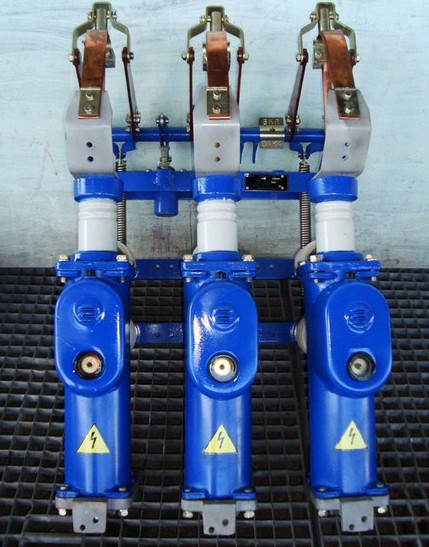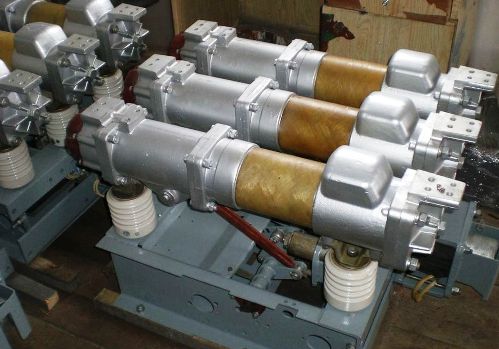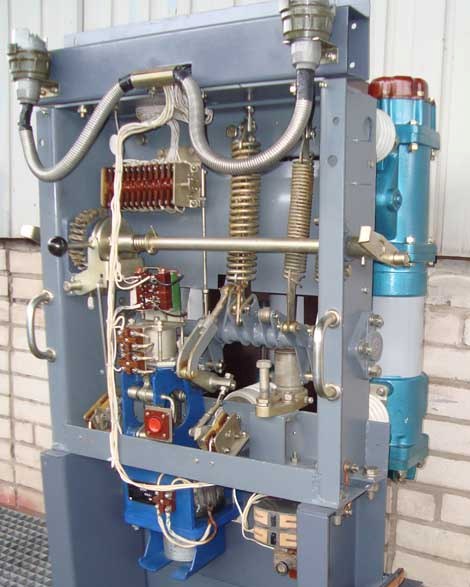Oil switches VMG, MG, VMP, VMK, MKP
Types of keys MV
The VMG133 switch (oil switch, low volume, pot type) is designed for indoor installation. The movable contact is a rod type, the fixed contact is a socket type. Instead of the VMG133, the VMG10 switch was released.

MGG and MG (oil sump switch) switches are low volume, for high rated currents, they have two parallel current-carrying circuits: the main circuit and the arc extinguishing circuit.
When the switch is closed, both circuits operate in parallel, with most of the current flowing through the low-impedance main circuit. When the circuit breaker is open, the main circuit contacts open before the arc circuit contacts.
The MG35 circuit breaker consists of three vertically arranged poles on one frame, where the actuator, common to the poles and current transformer boxes, is also fixed, two per pole.
VMP switches (suspended oil switch) are produced for voltages up to 35 kV in versions for KSO and KRU. Small volume switch, movable contact - rod, fixed - socket.

VMC (low oil column) circuit breakers are available for voltages 35-220 kV. The arc extinguishing device is attached to the upper flange, the contact rods pass through it from the bottom up. The breaker is operated by a built-in pneumatic actuator located in the base.
Switches MKP, Ural (U) and S (multi-volume oil switches) for a voltage of 35 kV are produced in the form of three-pole devices, each pole of which is assembled on a separate cover and placed in a separate tank. The switch and drive are mounted on a common frame to which a winch is attached for raising and lowering the oil tanks.
Circuit breakers for 110 and 220 kV are produced in the form of individual poles (tanks). All these switches have built-in current transformers — from two to four per pole.

Oil circuit breakers
Electromagnetic drive
The traction characteristic corresponds to the opposing forces characteristic of the oil breaker. A powerful DC (or rectified) current source is required. The cross-section of the power cables, selected according to the conditions of the voltage drop, turns out to be significant. Due to the high inductance of the electromagnet coils, the time
Oil switches 45 when switched on are large (up to 1 s). Electromagnetic AC units are also available. They are mainly used for low power switches.
Spring drive
The energy needed to turn it on is stored in a powerful spring, which is wound either manually or with the help of a low-power motor (up to 1 kW). The pulling force decreases towards the end of the closing stroke due to the reduced deformation of the springs.Drive speed allows perform auto-close cycles (automatic reclosing) and ABP (automatic inclusion of reserve).
The design advantage of the drive is the absence of a powerful source of direct current, compressed gas tanks, valves and pneumatic equipment. The disadvantage is that it can only be used for relatively small low-volume circuit breakers up to 110 kV.
Pneumatic drive
The energy is stored in a reservoir of compressed air that drives a piston in a cylinder. Air consumption allows 5-6 switching operations without pumping. Traction forces increase almost instantly and change little. The grip characteristic can be adjusted. The short switching time makes it possible to use the drive for the most powerful breakers. The disadvantage is the need to take special measures to ensure normal operation at low temperatures.
Pneumohydraulic drive
The energy required for ignition is stored by compressing the gas (usually nitrogen). The use of hydraulics makes it possible to significantly lighten the moving part of the breaker and obtain a compact mechanism. Start-up time can be shorter than pneumatic actuators. The drive allows for easy manual shifting.
The temperature range during normal operation is practically unlimited. Under certain conditions, manual actuators may be used to turn the circuit breaker on and off by pressing the hand on the lever or handwheel of the actuator; furthermore, shutdown can be automatic or remote.The fully assembled and overhauled oil circuit breaker is checked by the installation staff for simultaneous closing and opening of the contacts, the movement of the moving part, the pressure and travel of the contacts are measured.
See also on this topic: The device and principle of operation of the VMPE-10 oil circuit breaker
